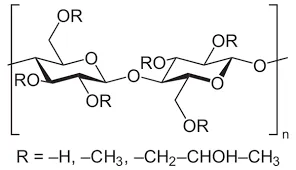
Nov . 26, 2024 08:05 Back to list
hydroxypropyl methyl
Understanding Hydroxypropyl Methylcellulose Properties, Applications, and Importance
Hydroxypropyl methylcellulose (HPMC) is a versatile polymer that has gained prominence in various industries, including pharmaceuticals, food, cosmetics, and construction. It is a non-toxic, biodegradable substance derived from cellulose, which is a natural component of plant cell walls. The unique properties and versatility of HPMC make it an essential ingredient for many products and applications.
Chemical Structure and Properties
HPMC is a modified cellulose ether consisting of hydroxypropyl and methyl groups grafted onto the cellulose backbone. This modification imparts specific characteristics to HPMC, such as enhanced solubility in water, superior film-forming capabilities, and increased viscosity. The degree of substitution (DS) of the hydroxypropyl and methyl groups can be altered to tailor the properties of HPMC for specific applications.
One of the standout features of HPMC is its ability to swell in water, forming a gel-like substance which makes it an effective thickening agent. Additionally, HPMC is characterized by its excellent thermal stability and resistance to chemical reactions, making it suitable for use in varying pH environments and temperatures. Its low toxicity and hypoallergenic nature further contribute to its wide acceptance in the food and pharmaceutical industries.
Applications in Pharmaceuticals
In the pharmaceutical industry, HPMC is primarily used as a binding agent, thickener, and film-forming agent in controlled-release formulations and tablets. Its ability to create a protective film helps in maintaining the stability of sensitive drug compounds while controlling the release rate of medication. This leads to more effective and sustained therapeutic action, reducing the need for multiple dosages throughout the day.
Moreover, HPMC is often utilized in the production of ophthalmic solutions and eye drops due to its lubricating properties. The presence of HPMC in these formulations increases viscosity and provides longer retention time in the eyes, improving patient comfort. Its use in hydrophilic matrix systems allows for a controlled and prolonged release of active ingredients, which is essential for maintaining therapeutic concentrations over extended periods.
Role in Food Industry
hydroxypropyl methyl

HPMC has also made significant contributions to the food industry, functioning as a stabilizer, emulsifier, and thickening agent. It is often found in gluten-free products, as it improves the texture and consistency of baked goods by enhancing water retention and providing structure. This is particularly crucial for consumers who require gluten-free options and wish to maintain a similar mouthfeel to traditional products.
Additionally, HPMC is used in sauces, dressings, and dairy products to prevent separation and enhance viscosity. Its ability to form gels and stabilize emulsions makes it invaluable for food product formulation, resulting in improved product quality and shelf life. As consumers increasingly seek clean-label products, the use of HPMC, a plant-derived ingredient, fits well within trends favoring natural and safe ingredients.
Use in Cosmetics and Personal Care
The cosmetic industry also benefits from the properties of HPMC. It is commonly added to lotions, creams, and shampoos to improve texture, stability, and moisture retention. HPMC serves as a thickener, helping to give products a desirable consistency while ensuring even distribution of active ingredients. Its film-forming properties enhance the sensory experience of the product when applied to the skin or hair.
Furthermore, due to its non-toxic and hypoallergenic nature, HPMC is a suitable choice for sensitive skin formulations. It acts as a moisturizing agent, providing a protective layer on the skin that helps to prevent moisture loss, thus promoting skin hydration and health.
Conclusion
Hydroxypropyl methylcellulose is a multifunctional ingredient with diverse applications across multiple sectors. Its unique chemical properties allow it to serve essential functions in pharmaceuticals, food production, and cosmetics. As an increasingly popular choice for formulators, HPMC enjoys growing acceptance due to its safety profile, effectiveness, and compatibility with other ingredients.
As industries continue to evolve, the demand for reliable, safe, and efficient ingredients like HPMC is likely to increase, marking its importance in the formulation of effective products that enhance quality and improve consumer experiences. Whether in medication, food, or personal care items, HPMC stands out as a pillar of modern formulation science.
-
Premium Cellulose Ether: Effective Liquid Thickener & Stabilizer
NewsAug.31,2025
-
HPMC for Tile Adhesive: Superior Bonding & Workability
NewsAug.30,2025
-
Premium Cellulose Ether: Effective Liquid Thickener Solutions
NewsAug.29,2025
-
HPMC for Tile Adhesive: Enhanced Bonding & Workability
NewsAug.28,2025
-
tile-bonding-additives-for-stronger-bonds
NewsAug.22,2025
-
construction-grade-rdp-for-wholesale-needs
NewsAug.22,2025







